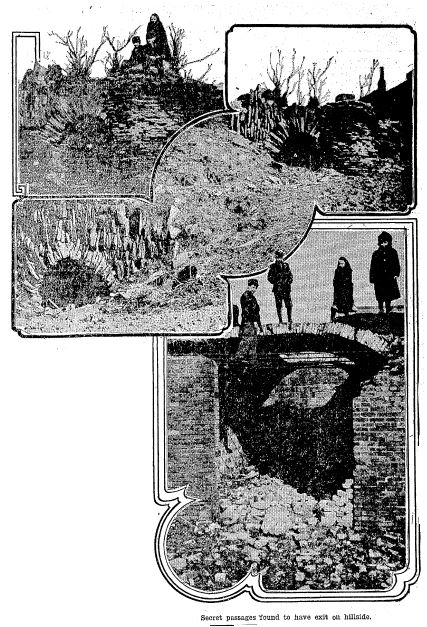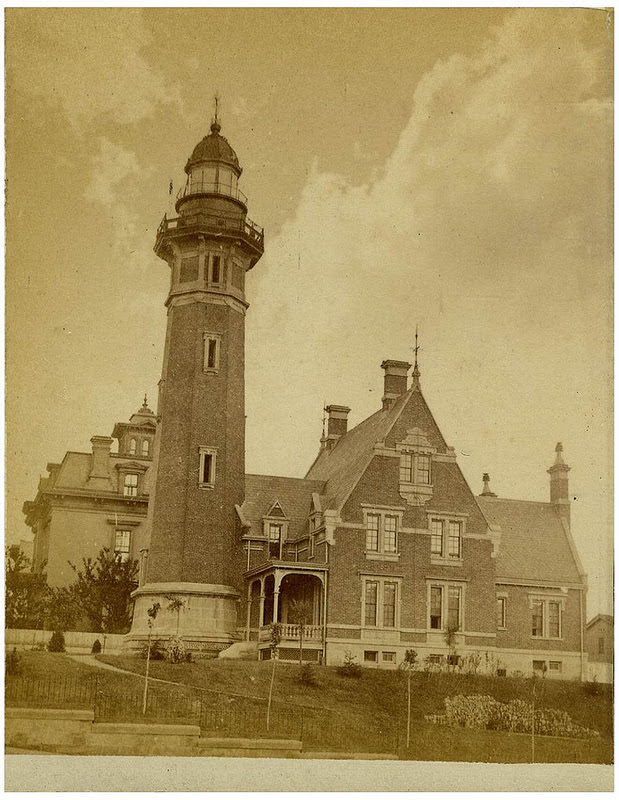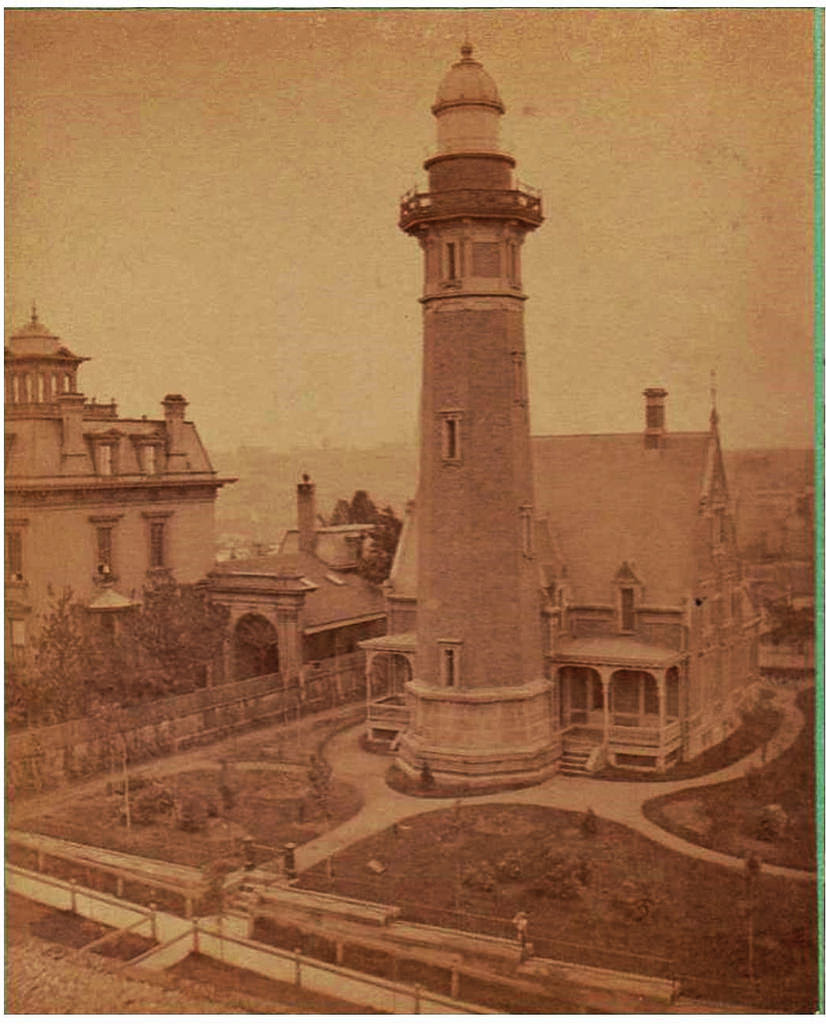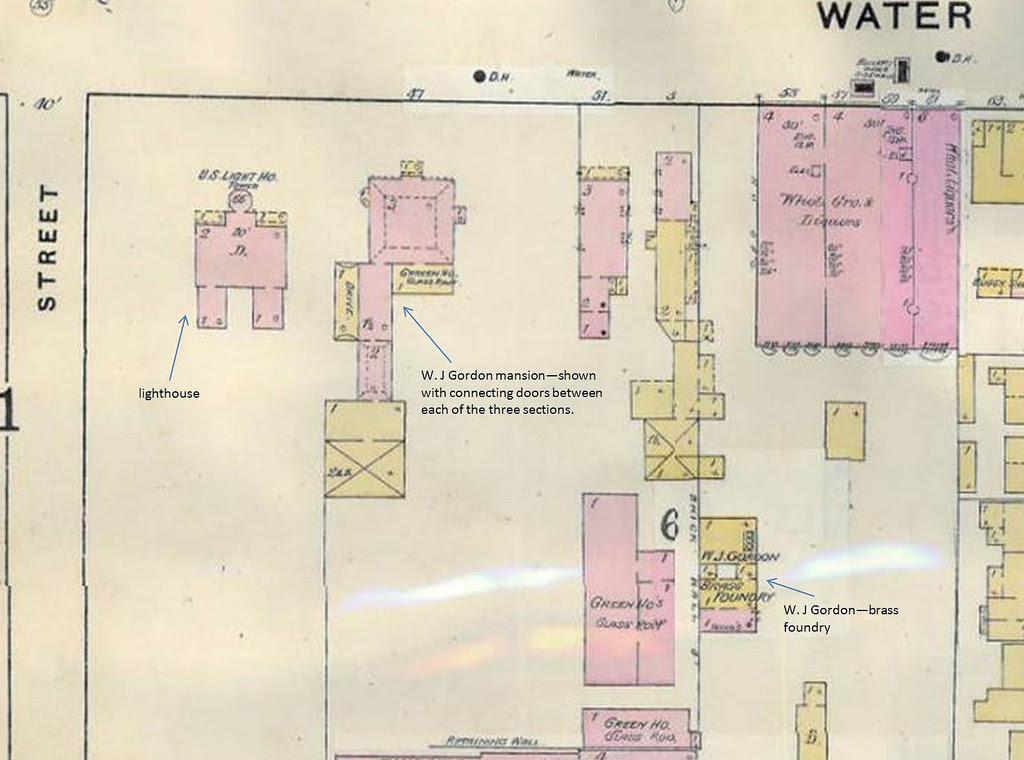Mr Gordon’s Castle of Mystery

Some of the tunnels at the Gordon mansion.
Although I require a general anaesthetic before being driven through any lengthy tunnel, there is something fascinating about long-lost underground passageways. I thought I knew most of the strange structures in northern Ohio (like the Lake Erie salt mines, Squire’s Castle, the Lake Erie water supply tunnels and “cribs,” and Franklin Castle—but this “Castle of Mystery” was new to me.
OLD GORDON HOME NEST OF TUNNELS
Wrecks Find Mansion of Cleveland Pioneer Real Castle of Mystery.
Secret Stairways, Subterranean Caves, Make Food for Speculation
Queer old secret tunnels, built sixty or seventy years ago, and leading from one of Cleveland’s oldest residences to artificial caves in the hillside above the Cuyahoga river, have been discovered in the demolition of the old W.J. Gordon homestead on W. 9th-st., opposite Lakeside-av.
The tunnels have existed for decades, unknown to people who have lived in the neighborhood for fifty or sixty years. Romance and mystery surround their early creation and use and many quaint traditions are connected with them.
Several months ago Goakes & Dettleback, real estate agents, purchased the old Gordon residence to reconvert it into a site for a big power block. When workmen began tearing the house down many unexpected queer things were discovered. It was found that the house was divided into three separate compartments and that it was impossible to get from one section to the other without going outdoors or through one of the tunnels to the big stone barn in the rear, where passageways led to the other divisions of the old house. Secret stairways and hidden closets abounded throughout the building and were located on every floor, secret cabinets being found even in the garret, near chimneys.
Made Fortune in Liquor.
The old house was built nearly seventy years ago by W.J. Gordon, a wholesale grocer and liquor dealer for many years, and the man who later gave Gordon park to the city. At the time the house was built, it is said, Gordon’s estate ran to the shores of the Cuyahoga river, it being before the B. & O. railroad was built and before W. 10th-st. was laid out. The ground was then terraced down from the hillside to the shore below, and on this hillside the tunnels emerged into outer light through a big artificial cave, made with pieces of rock fitted closely together and slightly arched to form a supporting roof.
Many Clevelanders will remember that for years an old rockery of rustic design stood in the rear of the Gordon homestead, which was surrounded by a big brick wall. It was at the foot of this rockery that the entrance to the tunnels was concealed by vines which grew in profusion everywhere until about twenty years ago when Mr. Gordon gave up occupation of the house and moved to a home on the Lake Shore boulevard.
Near the artificial cave is a large underground cellar, also screened with a rockery. It is arched with brick and has no openings, except the door, which was of oak set in the rockery work. The main tunnel from the cave led to the barn, fifty or sixty feet away. This barn had a basement and tunnels led to the three compartments of the house.
House Once Finest in City.
It is understood that the tunnels were built at the time the place was constructed. The house was one of the first residences in Cleveland when built and stood in the most fashionable section of the city. Business had not invaded the vicinity of the old Union depot.
Just what purpose the tunnels and strange compartments served nobody seems to know. Gordon was always considered eccentric, but his oddities in the construction of his home and grounds were never brought to light.
“I’ve lived in this neighborhood for fifty years,” said Joseph Roof of the William Edwards Co., W. 9th-st., yesterday, “and I never heard of the existence of these tunnels before. Few people, as far as I know, were ever intimate with Gordon while he lived in the old home, and the fact that the house was divided into three sections was never known to the neighbors.”
The old tunnels have been dug up to the point where they connected with the old barn, but there are still several sections which remain undisturbed. Sooner or later they will be pulled out to make storage space for the warehouse which will be erected within a few months. This building will have a frontage of seventy feet and a depth of 150 feet. It will be three stories high, with brick walls and re-enforced concrete floors. It will be used for manufacturing purposes. The old government lighthouse, demolished some time ago, was located on a lot adjoining the Gordon homestead. The rustic Gordon rockery, which towered for thirty feet in the air, has been torn down.
Plain Dealer [Cleveland, OH] 8 February 1909: p. 1, 3
William James Gordon was one of the most prominent businessmen and philanthropists in Cleveland. He made a fortune in grocery and liquor, then moved into iron and railroads. He also gave freely and discreetly to many charitable causes and interested himself in providing affordable housing for the masses as well as public gardens for recreation. He donated 122 acres of lakeside land from his estate to be used in perpetuity as Gordon Park. His biographies and obituaries stress his iron will, his rare sense for business, his hard-working and upright character. I was surprised to learn that he was also known as a connoisseur of fine horseflesh—he had extensive stables on the Gordon Park land—and his horses and racing exploits were often reported in the national press. His racing trainer was even present at his deathbed.
The Gordon mansion was built in the 1830s; I was unable to find an image of the mansion or its immense rockery. How much should we make of the fact that nobody knew (or remembered) about the tunnels? What about the statement above that “many quaint traditions are connected with them,” which suggests that the structures had passed into local folklore and had not been completely forgotten. Surely someone boating on the Cuyahoga River could have noticed that there were several “caves” on Gordon’s property–they look quite obvious in the photographs–although they may have been explained away as ornamental features.
Is it significant that the neighbors never realized that the house was divided into compartments? Gordon’s horse-racing interests suggest a man convivial, but not necessarily intimate with the neighbors. Yet, even if the neighbors didn’t know about the house’s curious construction, the servants most certainly did. It’s the kind of thing servants might gossip about so it is a little surprising that there were no rumors about the house. And what does “considered eccentric” mean?
Naturally the first thing suggested by secret rooms and passageways is “Underground Railroad,” and, in fact, Cleveland was an important stop on the route to Canada, even as early as the 1830s when the Gordon mansion was built. Perhaps the philanthropic Gordon was an abolitionist.
Although the description makes the mansion sound a bit like the Winchester Mystery House, there is no evidence that Gordon was interested in Spiritualism. However, he was a liquor wholesaler with a professional interest in spirits. The large scale of the artificial caves and tunnels and their location overlooking the Cuyahoga River suggests a smuggling operation. A small boat kept in one of the caves could be wheeled down to the river and sent off to cross the 55 miles of Lake Erie to Canada. Smuggled goods could be easily unloaded inside the caves and moved up the tunnels to the barn or to a secret room. The fact that the tunnel was wide enough for a wagon and went into the barn made it handy for moving contraband—human or liquid—on or off the premises.
The Gordon Mansion wasn’t the only mystery house in Cleveland. Legendary Franklin Castle, also built by a wholesale grocer and liquor dealer, Hannes Tiedemann, had its share of hidden staircases and passages, and secret rooms, including one containing a prohibition-era still and another holding hundreds of human bones—perhaps medical specimens. Yet another secret room was the site of a mass murder—some twenty German socialists machine-gunned in a political dispute. It was claimed that the death-room also held a Nazi spy’s radio. But this was long after Tiedemann built his elaborate and mysterious home where many members of his family died. It was whispered that Tiedemann murdered his young lover/daughter/servant-girl out of jealousy. The house passed through many owners after Tiedemann and today stands boarded up after a fire. Naturally it is rumored to be haunted by a young woman in black.
There seems to be no mention of the Gordon house tunnels in the standard Cleveland histories and there are apparently no ghost or treasure stories about Gordon himself, which is disappointing. I would have liked to find that the artificial caves were actually a Temple of Mithras, the last resting place of the Most Holy Grail, or the clubhouse of the northeastern Ohio branch of the Hell-fire Club. But smuggling seems the most plausible, and >sigh< prosaic, idea.
Any other theories? Dig deep and send to Chriswoodyard8 AT gmail.com
Danny very kindly sent me some pictures of the Gordon Mansion and the lighthouse mentioned above.

Gordon Mansion and lighthouse.

This shows the three sections of the Gordon mansion, as well as the lighthouse. Photo credit: Michael Forand. http://www.ipernity.com/doc/326571/31521933/in/album/637935

Map of the Gordon mansion grounds, which Danny helpfully annotated.
